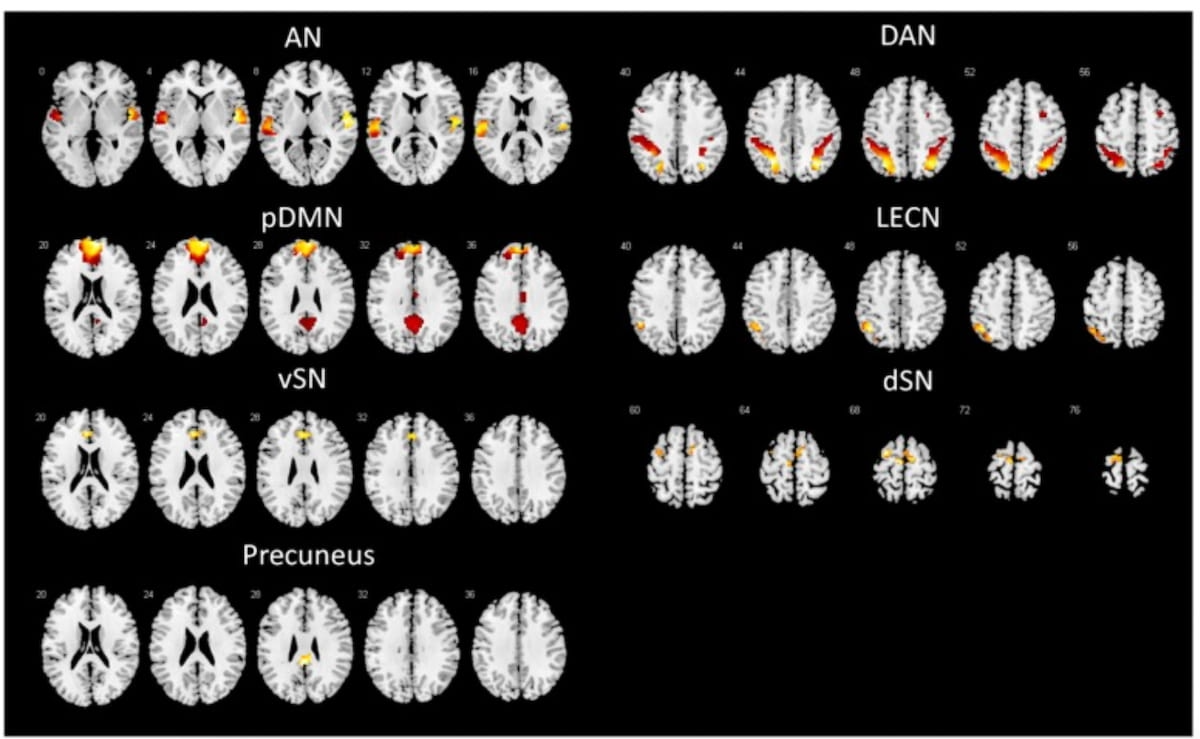Could key changes in intra-network connectivity revealed on brain magnetic resonance imaging (MRI) scans indicate the development of Alzheimer’s disease or Parkinson’s disease in patients with mild cognitive impairment (MCI)?
For a new study, recently published in Academic Radiology, researchers reviewed cognitive function assessments and resting-state functional MRI (fMRI) data for 33 patients who had MCI prior to Alzheimer’s disease (AD), 55 patients who had MCI prior to developing Parkinson’s disease (PD) and 34 healthy controls. The cognitive function assessments with the Mini-Mental State Examination (MMSE) and Montreal Cognitive Assessment (MoCA) were performed within one hour prior to fMRI, according to the study.
In comparison to healthy patients, the researchers found that those in the AD-MCI cohort exhibited decreased connectivity between the dorsal default mode network (dDMN) and the right executive control network (RECN), the dorsal salience network (dSN) and ventral default mode network (vDMN). The study authors also noted decreased connectivity between the vDMN and left executive control network (LECN) in this patient population.
The fMRI findings in the AD-MCI group revealed decreased functional connectivity (FC) in the left superior parietal gyrus in the visuospatial network, the left inferior parietal gyrus in the LECN and the right precuneus and right superior medial frontal gyrus in the dDMN, according to the researchers.
“Reduced intra-network functional connectivity within the DMN (default mode network) is the core alteration in AD-MCI. … Intra-network functional connectivity of the DMN decreases in the early stages of AD. As the disease progresses, this deposition manifests macroscopically as reductions in inter-network functional connectivity both between different sub-networks of the DMN and between the DMN and other networks,” wrote lead study author Juzhou Wang, M.D., who is affiliated with the Department of Radiology at the First Hospital of China Medical University in Liaoning, China, and colleagues.
For patients in the PD-MCI cohort, the study authors found decreased connectivity between the dSN and the dDMN, vDMN and LECN along with increased connectivity between the dSN and ventral salience network (vSN) in contrast to healthy patients.
(Editor’s note: For additional MRI-related content, click here.)
When assessing intra-network connectivity, the researchers noted that the PD-MCI group had decreased FC in the left posterior cingulate in the precuneus as well as the left anterior cingulate and left superior frontal gyrus in comparison to patients in the AD-MCI cohort. They also pointed out increased FC in the right superior medial frontal gyrus in the dDMN and the left superior parietal gyrus in the visuospatial network for those with AD-MCI.
“ … Compared to AD-MCI, the decrease in intra-network functional connectivity within the DMN is less pronounced in PD-MCI. This may be due to the loss of inhibitory control from the SN (salience network), leading to a modest increase in excitability within the DMN,” suggested Wang and colleagues. “Nonetheless, the DMN remains suppressed in response to external stimuli at the PD-MCI stage, which might explain why functional connectivity levels of the DMN are inversely correlated with visuospatial and executive abilities and abstract thinking in PD-MCI.”
Three Key Takeaways
- Altered functional connectivity (FC) in early Alzheimer's and Parkinson's disease. The study highlights that decreased intra-network functional connectivity primarily within the default mode network (DMN) is a hallmark of Alzheimer's-related mild cognitive impairment (AD-MCI). Conversely, Parkinson's-related MCI (PD-MCI) shows an emphasis of decreased FC in the salience network (SN) and unique alterations in the DMN, indicating disease-specific patterns.
- Diagnostic sensitivity of FC changes. Functional connectivity changes in the DMN, SN, and precuneus are proposed as sensitive markers for early diagnosis, monitoring, and prognosis of AD-MCI and PD-MCI. The shared alteration in the precuneus across both diseases may offer a focal point for diagnostic and therapeutic strategies.
- Therapeutic implications. The study suggests that the precuneus could serve as a target for repetitive transcranial magnetic stimulation (rTMS) in treating cognitive dysfunction, potentially opening pathways for non-invasive interventions in mild cognitive impairment (MCI) progression.
The study authors maintained that reduced inter-network FC primarily centered around the DMN in patients with AD-MCI whereas the decreased inter-network FC in the PD-MCI cohort primarily involved the SN.
“FC changes in DMN and SN may be the most sensitive indicators for early clinical diagnosis. Additionally, FC within the DMN, SN, and precuneus, as well as between the DMN and SN, can serve as sensitive indicators for monitoring and prognosis. Moreover, the precuneus, as the most prominent shared alteration between the two diseases, may become a key target for rTMS (repetitive transcranial magnetic stimulation) in the future treatment of cognitive dysfunction,” posited Wang and colleagues.
(Editor’s note: For related content, see “Study Assesses Amyloid PET/MRI Combination in Detection of Alzheimer’s Disease,” “A Closer Look at the New Appropriate Use Criteria for Brain PET: An Interview with Phillip Kuo, MD, Part 1” and “Can Brain MRI-Based Connectome Mapping Predict the Progression of Parkinson’s Disease?”)
In regard to study limitations, the authors acknowledged the cross-sectional nature of the study and the relatively small cohort. They also conceded that going beyond the use of MOCA and MMSE is necessary, emphasizing that evaluations with a focus on cognitive subdomains are necessary to assess cognitive capabilities.
